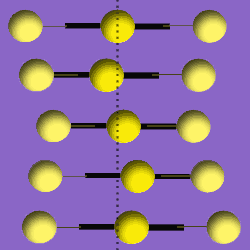Do the Nano-Locomotion

Like a futuristic submarine, a newly designed nanomachine would thrust itself through fluid using an unusual type of propulsion. In the June Physical Review E a research team proposes a simple, sphere-and-rod device that swims by changing its length along only one dimension. Its simplicity may make it attractive to engineers, who could use the “swimmer” to move nano-cargo through liquid environments, such as water or a bloodstream.
The world is a much stickier place for tiny things under water. Scuba divers can glide peacefully once they build up some momentum with a few kicks. But molecular-sized objects don’t have that luxury–they must constantly struggle against the water’s viscosity, which impedes their progress like thick molasses. In that environment, motions that reverse themselves exactly–such as a diver’s scissor kick–will do nothing more than return an object back to its original place. Only motions that do not look the same in reverse, so-called non-reciprocal motions, such as the rotation of a bacterium’s flagellum, can advance the swimmer in one direction.
Ramin Golestanian, of the Institute for Advanced Studies of Basic Sciences in Iran, and Ali Najafi, now of Zanjan University in Iran, used the principle of non-reciprocal motion to design the most basic nano-swimmer they could imagine, far simpler than most found in nature. It consists of three spheres in a row connected by two rigid rods. The rods sequentially contract and expand in length: First the left side contracts, then the right side follows, then the two rods expand in the same order (see animation below). The cycle of motion effectively causes the spheres to grab onto the surrounding fluid and pull the device forward like a worm moving through earth. Golestanian says the simplicity of the model should help nanotechnology engineers overcome the mathematical hurdles of more complex motions. “It’s a new solution to an old problem,” he says.
To find out whether the swimmer will really work, however, the theoretical model must be made more “robust,” says Golestanian. Teaming up with Armand Ajdari of the Institute of Industrial Physics and Chemistry (ESPCI) in Paris, Golestanian and Najafi hope to account for gravity, internal noise from the engines, and random collisions with individual molecules in a liquid. Then there’s the matter of construction materials. Nanotechnology is still in its infancy, but Golestanian guesses that the swimmer would be powered by molecular motors–molecules whose bonds expand and contract with energy produced by biochemical reactions or in response to light. Once built, it might someday deliver medicine in the human body or conduct research on cells.
Golestanian and Najafi’s model is a welcome addition to the literature on nanolocomotive designs that has accumulated in recent years, says Markus Porto, of the Darmstadt Technical University in Germany, who has proposed a non-swimming molecular motor [1]. “I think that to construct man-made machinery on the nanoscale is one of the biggest challenges in present research in physics and chemistry,” he says.
–Chelsea Wald
References
- M. Porto, M. Urbakh, and J. Klafter, “Atomic Scale Engines: Cars and Wheels,” Phys. Rev. Lett. 84, 6058 (2000)
More Information
Porto’s “engines page” with movies of his proposed molecular motors and links to related sites.


